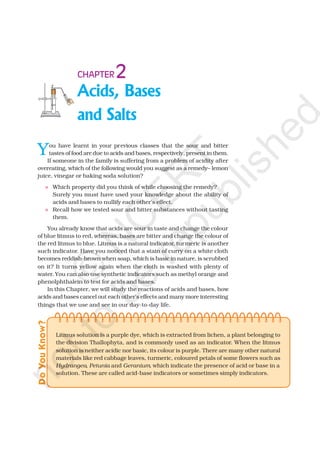The document discusses acids and bases and their chemical properties. It describes several activities where students test different substances as acids and bases using indicators like litmus paper and observe reactions. For example, acids react with metals to produce salts and hydrogen gas. Metal carbonates and hydrogencarbonates react with acids to produce salts, carbon dioxide and water. Acids and bases neutralize each other, producing salts and water. Metallic oxides react with acids similarly to bases. A non-metallic oxide like carbon dioxide reacts with a base like calcium hydroxide to form a salt and water.

![Science18
2.12.12.12.12.1 UNDERSTUNDERSTUNDERSTUNDERSTUNDERSTANDING THE CHEMICANDING THE CHEMICANDING THE CHEMICANDING THE CHEMICANDING THE CHEMICAL PROPERTIES OFAL PROPERTIES OFAL PROPERTIES OFAL PROPERTIES OFAL PROPERTIES OF
ACIDS AND BASESACIDS AND BASESACIDS AND BASESACIDS AND BASESACIDS AND BASES
2.1.1 Acids and Bases in the Laboratory
Activity 2.1Activity 2.1Activity 2.1Activity 2.1Activity 2.1
These indicators tell us whether a substance is acidic or basic by
change in colour. There are some substances whose odour changes in
acidic or basic media. These are called olfactory indicators. Let us try
out some of these indicators.
Q U E S T I O N
?
1. You have been provided with three test tubes. One of them contains
distilled water and the other two contain an acidic solution and a basic
solution, respectively. If you are given only red litmus paper, how will
you identify the contents of each test tube?
Collect the following samples from the science laboratory–
hydrochloric acid (HCl), sulphuric acid (H2
SO4
), nitric acid (HNO3
),
acetic acid (CH3
COOH), sodium hydroxide (NaOH), calcium
hydroxide [Ca(OH)2
], potassium hydroxide (KOH), magnesium
hydroxide [Mg(OH)2
], and ammonium hydroxide (NH4
OH).
Put a drop of each of the above solutions on a watch-glass and
test with a drop of the following indicators as shown in Table 2.1.
What change in colour did you observe with red litmus, blue litmus,
phenolphthalein and methyl orange solutions for each of the
solutions taken?
Tabulate your observations in Table 2.1.
Table 2.1
Sample Red Blue Phenolph- Methyl
solution litmus litmus -thalein orange
solution solution solution solution
Activity 2.2Activity 2.2Activity 2.2Activity 2.2Activity 2.2
Take some finely chopped onions in a plastic bag along with some
strips of clean cloth. Tie up the bag tightly and leave overnight in
the fridge. The cloth strips can now be used to test for acids and
bases.
Take two of these cloth strips and check their odour.
Keep them on a clean surface and put a few drops of dilute HCl
solution on one strip and a few drops of dilute NaOH solution on
the other.
©
N
C
ER
T
notto
be
republished](https://image.slidesharecdn.com/jesc102-160723160232/85/acids-basis-and-salts-2-320.jpg)











![Science30
Common salt — A raw material for chemicals
The common salt thus obtained is an important raw material for various
materials of daily use, such as sodium hydroxide, baking soda, washing
soda, bleaching powder and many more. Let us see how one substance
is used for making all these different substances.
Sodium hydroxide
When electricity is passed through an aqueous solution of sodium
chloride (called brine), it decomposes to form sodium hydroxide. The
process is called the chlor-alkali process because of the products formed–
chlor for chlorine and alkali for sodium hydroxide.
2NaCl(aq) + 2H2
O(l) → 2NaOH(aq) + Cl2
(g) + H2
(g)
Chlorine gas is given off at the anode, and hydrogen gas at the cathode.
Sodium hydroxide solution is formed near the cathode. The three
products produced in this process are all useful. Figure 2.8 shows the
different uses of these products.
Bleaching powder
You have already come to know that chlorine is produced during the
electrolysis of aqueous sodium chloride (brine). This chlorine gas is used
for the manufacture of bleaching powder. Bleaching powder is produced
by the action of chlorine on dry slaked lime [Ca(OH)2]. Bleaching powder
is represented as CaOCl2
, though the actual composition is quite
complex.
Ca(OH)2
+ Cl2
→ CaOCl2
+ H2
O
Figure 2.8 Important products from the chlor-alkali process
©
N
C
ER
T
notto
be
republished](https://image.slidesharecdn.com/jesc102-160723160232/85/acids-basis-and-salts-14-320.jpg)





